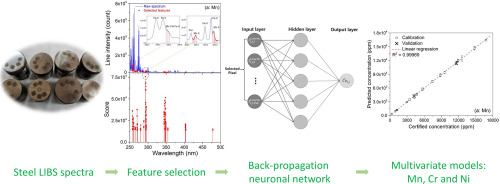当前位置:
X-MOL 学术
›
Spectrochim. Acta B. At. Spectrosc.
›
论文详情
Our official English website, www.x-mol.net, welcomes your
feedback! (Note: you will need to create a separate account there.)
Determination of minor metal elements in steel using laser-induced breakdown spectroscopy combined with machine learning algorithms
Spectrochimica Acta Part B: Atomic Spectroscopy ( IF 3.2 ) Pub Date : 2020-04-01 , DOI: 10.1016/j.sab.2020.105802 Yuqing Zhang , Chen Sun , Liang Gao , Zengqi Yue , Sahar Shabbir , Weijie Xu , Mengting Wu , Jin Yu
Spectrochimica Acta Part B: Atomic Spectroscopy ( IF 3.2 ) Pub Date : 2020-04-01 , DOI: 10.1016/j.sab.2020.105802 Yuqing Zhang , Chen Sun , Liang Gao , Zengqi Yue , Sahar Shabbir , Weijie Xu , Mengting Wu , Jin Yu

|
Abstract The properties of a steel are crucially influenced by the contained minor elements, including metals, such as Mn, Cr and Ni. The determination of their concentrations using laser-induced breakdown spectroscopy (LIBS) represents a great help in many application scenarios, especially with in situ and online measurement requirements. Such determination can be significantly perturbed by spectral interferences with Fe I and Fe II lines which is particularly dense in the VIS and near UV ranges. Univariate regression can sometimes, lead to calibration models with modest analytical performances. In this work, multivariate calibration models are developed using a machine learning approach. We first show the regression results with univariate models. The development of multivariate models is then briefly presented, in successive steps of data pretreatment, feature selection with SelectKBest algorithm and regression model training with back-propagation neural network (BPNN). The analytical performances obtained with the developed multivariate models are compared with those obtained with the univariate models. We demonstrate in such way, the efficiency of the machine learning approach in the development of multivariate models for calibration and prediction with LIBS spectra acquired from steel samples. In particular, the prediction trueness (relative error of prediction) and precision (relative standard deviation) for the determination of the above mentioned metal elements in steel reach the respective values of 1.13%, 2.85%, 7.20% (for Mn, Cr, Ni) and 6.68%, 3.96%, 6.52% (for Mn, Cr, Ni) with the used experimental condition and measurement protocol.
中文翻译:

使用激光诱导击穿光谱结合机器学习算法测定钢中的微量金属元素
摘要 钢的性能受所含微量元素的影响很大,包括金属,如Mn、Cr和Ni。使用激光诱导击穿光谱 (LIBS) 确定它们的浓度在许多应用场景中都有很大帮助,尤其是在原位和在线测量要求中。这种确定可能会受到与 Fe I 和 Fe II 谱线的光谱干扰的显着干扰,这些谱线在可见光和近紫外范围内特别密集。单变量回归有时会导致校准模型的分析性能适中。在这项工作中,使用机器学习方法开发了多变量校准模型。我们首先展示了单变量模型的回归结果。然后简要介绍多元模型的发展,在数据预处理、使用 SelectKBest 算法的特征选择和使用反向传播神经网络 (BPNN) 的回归模型训练的连续步骤中。将使用开发的多变量模型获得的分析性能与使用单变量模型获得的性能进行比较。我们以这种方式证明了机器学习方法在开发用于校准和预测多变量模型的效率,该模型使用从钢样品中获得的 LIBS 光谱。特别是测定钢中上述金属元素的预测正确度(预测的相对误差)和精密度(相对标准偏差)分别达到1.13%、2.85%、7.20%(对于Mn、Cr、Ni) ) 和 6.68%、3.96%、6.52%(对于 Mn、Cr、Ni)以及使用的实验条件和测量方案。使用 SelectKBest 算法进行特征选择,使用反向传播神经网络 (BPNN) 进行回归模型训练。将使用开发的多变量模型获得的分析性能与使用单变量模型获得的性能进行比较。我们以这种方式证明了机器学习方法在开发用于校准和预测多变量模型的效率,该模型使用从钢样品中获得的 LIBS 光谱。特别是测定钢中上述金属元素的预测正确度(预测的相对误差)和精密度(相对标准偏差)分别达到1.13%、2.85%、7.20%(对于Mn、Cr、Ni) ) 和 6.68%、3.96%、6.52%(对于 Mn、Cr、Ni)以及使用的实验条件和测量方案。使用 SelectKBest 算法进行特征选择,使用反向传播神经网络 (BPNN) 进行回归模型训练。将使用开发的多变量模型获得的分析性能与使用单变量模型获得的性能进行比较。我们以这种方式证明了机器学习方法在开发用于校准和预测多变量模型的效率,该模型使用从钢样品中获得的 LIBS 光谱。特别是测定钢中上述金属元素的预测正确度(预测的相对误差)和精密度(相对标准偏差)分别达到1.13%、2.85%、7.20%(对于Mn、Cr、Ni) ) 和 6.68%、3.96%、6.52%(对于 Mn、Cr、Ni)以及使用的实验条件和测量方案。
更新日期:2020-04-01
中文翻译:

使用激光诱导击穿光谱结合机器学习算法测定钢中的微量金属元素
摘要 钢的性能受所含微量元素的影响很大,包括金属,如Mn、Cr和Ni。使用激光诱导击穿光谱 (LIBS) 确定它们的浓度在许多应用场景中都有很大帮助,尤其是在原位和在线测量要求中。这种确定可能会受到与 Fe I 和 Fe II 谱线的光谱干扰的显着干扰,这些谱线在可见光和近紫外范围内特别密集。单变量回归有时会导致校准模型的分析性能适中。在这项工作中,使用机器学习方法开发了多变量校准模型。我们首先展示了单变量模型的回归结果。然后简要介绍多元模型的发展,在数据预处理、使用 SelectKBest 算法的特征选择和使用反向传播神经网络 (BPNN) 的回归模型训练的连续步骤中。将使用开发的多变量模型获得的分析性能与使用单变量模型获得的性能进行比较。我们以这种方式证明了机器学习方法在开发用于校准和预测多变量模型的效率,该模型使用从钢样品中获得的 LIBS 光谱。特别是测定钢中上述金属元素的预测正确度(预测的相对误差)和精密度(相对标准偏差)分别达到1.13%、2.85%、7.20%(对于Mn、Cr、Ni) ) 和 6.68%、3.96%、6.52%(对于 Mn、Cr、Ni)以及使用的实验条件和测量方案。使用 SelectKBest 算法进行特征选择,使用反向传播神经网络 (BPNN) 进行回归模型训练。将使用开发的多变量模型获得的分析性能与使用单变量模型获得的性能进行比较。我们以这种方式证明了机器学习方法在开发用于校准和预测多变量模型的效率,该模型使用从钢样品中获得的 LIBS 光谱。特别是测定钢中上述金属元素的预测正确度(预测的相对误差)和精密度(相对标准偏差)分别达到1.13%、2.85%、7.20%(对于Mn、Cr、Ni) ) 和 6.68%、3.96%、6.52%(对于 Mn、Cr、Ni)以及使用的实验条件和测量方案。使用 SelectKBest 算法进行特征选择,使用反向传播神经网络 (BPNN) 进行回归模型训练。将使用开发的多变量模型获得的分析性能与使用单变量模型获得的性能进行比较。我们以这种方式证明了机器学习方法在开发用于校准和预测多变量模型的效率,该模型使用从钢样品中获得的 LIBS 光谱。特别是测定钢中上述金属元素的预测正确度(预测的相对误差)和精密度(相对标准偏差)分别达到1.13%、2.85%、7.20%(对于Mn、Cr、Ni) ) 和 6.68%、3.96%、6.52%(对于 Mn、Cr、Ni)以及使用的实验条件和测量方案。











































 京公网安备 11010802027423号
京公网安备 11010802027423号